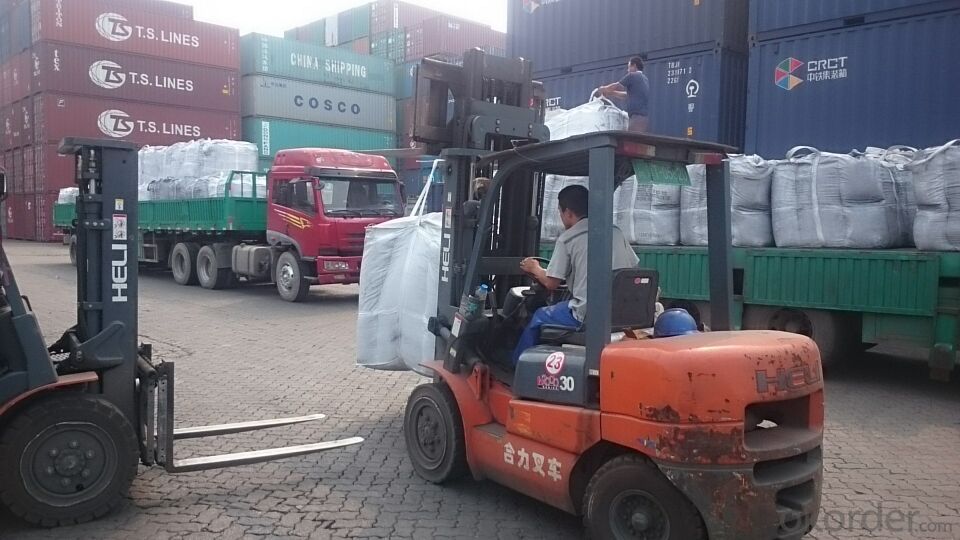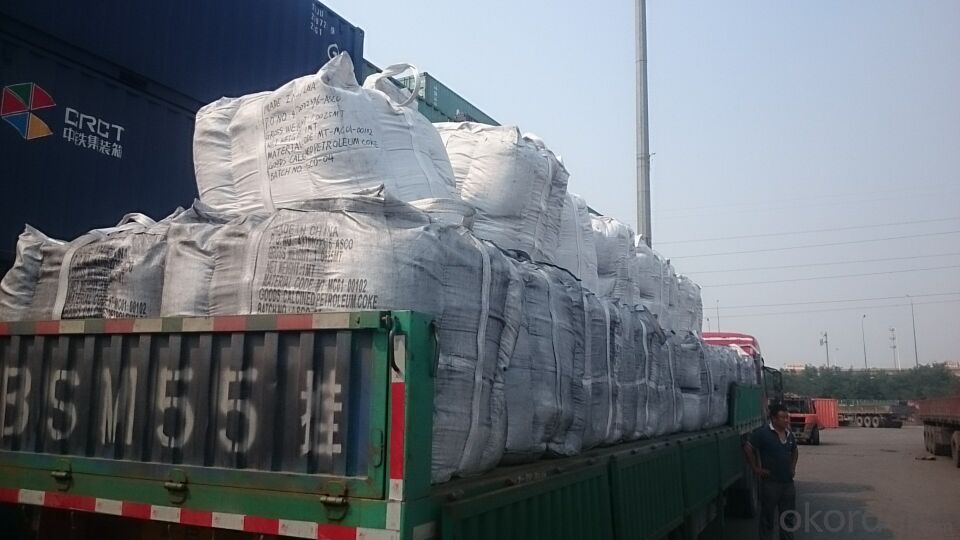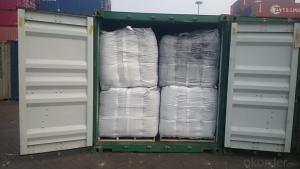GPC with lower Sulphur0.03% max with Moisture 0.5%
- Loading Port:
- Tianjin
- Payment Terms:
- TT OR LC
- Min Order Qty:
- 22 m.t.
- Supply Capability:
- 5000 m.t./month
OKorder Service Pledge
OKorder Financial Service
You Might Also Like
Introduction:
GPC has good characteristics with low ash, low resistivity, low sulphur, high carbon and high density. It is the best material for high quality carbon products. It is used as carbon additive in steel industry or fuel.
Features:
1.Our strong team provide you reliable service that make you feel purchasing is more easier
2. We ensure that we can supply capability with competitive price.
3. Work strictly to guarantee product quality,
4. Highest standard of integrity. Guarantee customer's benefit.
5. Supplying Pet Coke, Met coke, Foundry Coke, Carbon Raiser etc.
Specifications:
F.C.% | 95MIN | 94MIN | 93MIN | 92MIN | 90MIN | 85MIN | 84MIN |
ASH % | 4MAX | 5MAX | 6 MAX | 6.5MAX | 8.5MAX | 12MAX | 13MAX |
V.M.% | 1 MAX | 1MAX | 1.0MAX | 1.5MAX | 1.5MAX | 3 MAX | 3 MAX |
SULFUR % | 0.3MAX | 0.3MAX | 0.3MAX | 0.35MAX | 0.35MAX | 0.5MAX | 0.5MAX |
MOISTURE % | 0.5MAX | 0.5MAX | 0.5MAX | 0.5MAX | 0.5MAX | 1MAX | 1MAX |
Pictures



FAQ:
1. Your specification is not very suitable for us.
Please offer us specific indicators by TM or email. We will give you feedback as soon as possible.
2. When can I get the price?
We usually quote within 24 hours after getting your detailed requirements, like size, quantity etc. .
If it is an urgent order, you can call us directly.
3. Do you provide samples?
Yes, samples are available for you to check our quality.
Samples delivery time will be about 3-10 days.
4. What about the lead time for mass product?
The lead time is based on the quantity, about 7-15 days. For graphite product, apply Dual-use items license need about 15-20 working days.
5. What is your terms of delivery?
We accept FOB, CFR, CIF, EXW, etc. You can choose the most convenient way for you. Besides that,
we can also shipping by Air and Express.
6. Product packaging?
We are packed in bulk ship or in ton bag or placing in container or according to your requirements.
7. Notice
please note that the price on Alibaba is a rough price. The actual price will depends on raw materials, exchange rate wage and your order quantity .Hope to cooperation with you, thanks !
- Q:What are the impacts of carbon emissions on the stability of islands?
- The impacts of carbon emissions on the stability of islands are significant and wide-ranging. Carbon emissions contribute to climate change, which in turn leads to sea level rise, increased storm intensity, and ocean acidification – all of which pose great threats to the stability of islands. Sea level rise is one of the most immediate and visible impacts of carbon emissions on islands. As global temperatures rise, glaciers and ice caps melt, and ocean waters expand, causing sea levels to gradually increase. This rise in sea level puts low-lying islands at risk of inundation, erosion, and even disappearing completely. Many small islands, particularly in the Pacific and Indian Oceans, are already experiencing the effects of rising sea levels, leading to loss of land, displacement of populations, and destruction of infrastructure. Another impact of carbon emissions on islands is the increased intensity and frequency of storms. Warmer ocean temperatures fuel the formation of tropical storms and hurricanes, which can cause devastating damage to island communities. These storms can result in widespread destruction of homes, infrastructure, and ecosystems, leading to long-term economic and social disruptions. Islands are particularly vulnerable to storm surges, which occur when high winds push seawater onto land, causing extensive flooding and erosion. Ocean acidification, caused by the absorption of excess carbon dioxide by the ocean, is another significant impact of carbon emissions on islands. Increased levels of carbon dioxide in the atmosphere lead to increased absorption by the ocean, resulting in a decrease in pH levels and making the ocean more acidic. This acidification poses a threat to coral reefs, which are vital for island ecosystems and serve as natural barriers against wave action and storm surge. Coral reefs provide habitats for a wide array of marine life and are important for tourism and local economies. The loss or degradation of coral reefs due to ocean acidification affects not only the biodiversity but also the resilience of islands to climate-related impacts. Overall, the impacts of carbon emissions on the stability of islands are profound and severe. Rising sea levels, increased storm intensity, and ocean acidification all pose significant threats to the physical and social stability of island communities. Urgent action is needed to mitigate carbon emissions, invest in adaptation measures, and support island nations in building resilience to these impacts.
- Q:How are carbon nanotubes produced?
- Chemical vapor deposition (CVD) is the process responsible for the production of carbon nanotubes. This process utilizes a carbon-containing gas and a catalyst. The catalyst material, typically iron, nickel, or cobalt, is applied to a substrate. Subsequently, the substrate is placed in a high-temperature furnace, typically around 800-1000 degrees Celsius, and exposed to a carbon-containing gas, such as methane or ethylene. At high temperatures, the gas decomposes, releasing carbon atoms that adhere to the catalyst nanoparticles on the substrate. These carbon atoms arrange themselves in a hexagonal pattern, forming tube-like structures that grow vertically from the catalyst particles. The growth of the nanotubes is driven by the difference in carbon solubility between the catalyst and the growing tube. Various parameters, including temperature, gas flow rate, and catalyst material, can be adjusted to control the diameter, length, and alignment of the carbon nanotubes. Manipulating these parameters enables researchers to produce carbon nanotubes with specific characteristics suitable for different applications. It is important to note that other methods, such as arc discharge and laser ablation, can also be employed to produce carbon nanotubes. However, CVD is the most widely used method due to its scalability and ability to produce substantial quantities of nanotubes. Furthermore, CVD allows for the growth of vertically aligned nanotube arrays, which are highly sought after in numerous applications.
- Q:How does carbon contribute to the flavor of food?
- Carbon contributes to the flavor of food through the process of caramelization, which occurs when sugars break down and react with heat. This reaction produces a variety of flavor compounds, including those that give foods a rich, nutty, or sweet taste. Additionally, carbon is an essential component of organic molecules like amino acids and fats, which play a crucial role in creating the overall flavor profile of different foods.
- Q:How does carbon impact the productivity of marine ecosystems?
- Carbon impacts the productivity of marine ecosystems in several ways. One of the main ways is through ocean acidification. When carbon dioxide from human activities is released into the atmosphere, a significant portion of it gets absorbed by the oceans. This excess carbon dioxide reacts with seawater to form carbonic acid, leading to a decrease in the pH of the ocean. This increase in acidity has detrimental effects on many marine organisms, especially those that rely on calcium carbonate to build their shells or skeletons, such as corals, shellfish, and some plankton species. Ocean acidification inhibits the process of calcification, making it difficult for these organisms to develop and maintain their protective structures. This not only affects their survival but also impacts the entire food chain. Many species rely on these calcium carbonate structures as a food source or for shelter, so a decline in their productivity can have cascading effects on the ecosystem. Additionally, increased carbon dioxide levels in the ocean can also affect the metabolism and physiology of marine organisms. Some studies have found that elevated CO2 concentrations can impair the growth, development, and reproductive success of certain species. This can lead to a decrease in overall productivity within the ecosystem. Furthermore, climate change, driven by the accumulation of carbon dioxide in the atmosphere, also impacts marine ecosystems. Rising temperatures can disrupt the delicate balance of marine ecosystems, affecting the distribution and abundance of species, altering predator-prey relationships, and leading to changes in the timing of vital ecological events such as spawning or migration. These changes can have profound impacts on the productivity of marine ecosystems, as different species may struggle to adapt or compete under new conditions. In conclusion, carbon dioxide emissions have far-reaching consequences for marine ecosystems. Ocean acidification and climate change, driven by excessive carbon dioxide, have detrimental effects on the productivity of marine ecosystems, affecting the growth, survival, and reproductive success of marine organisms. The impacts of carbon on marine ecosystems highlight the urgent need to reduce greenhouse gas emissions and mitigate the effects of climate change to protect these fragile and vital ecosystems.
- Q:What are the applications of graphite in industry?
- Graphite possesses distinct properties that make it suitable for a range of applications across industries. Here are several key uses of graphite in different industrial sectors: 1. Lubricants: Given its low friction coefficient, graphite is extensively employed as a solid lubricant in industries that encounter high temperatures and extreme pressures, like automotive, aerospace, and heavy machinery. 2. Refractories: Graphite's exceptional heat and chemical resistance make it an ideal material for manufacturing refractory products. It helps line furnaces, crucibles, and other high-temperature equipment in metal production, glass manufacturing, and chemical processing. 3. Electrical industry: Graphite's excellent electrical conductivity makes it widely utilized in this sector. It is employed to produce electrodes, brushes, and contacts for electrical motors, generators, and batteries. Furthermore, graphite serves as a component in electrical discharge machining (EDM) and conductive paints and coatings. 4. Foundry industry: Graphite acts as a mold and core material in the foundry industry, owing to its high thermal conductivity and ability to withstand high temperatures. It finds application in various metal casting processes, including sand casting, investment casting, and continuous casting. 5. Chemical industry: The chemical industry benefits from graphite's corrosion resistance and capacity to endure high temperatures. It is utilized in the manufacture of chemical equipment such as heat exchangers, reactors, and pipes, where it can withstand aggressive chemical environments. 6. Nuclear industry: In the nuclear industry, graphite serves as a moderator in nuclear reactors. Its ability to slow down neutrons allows for controlled nuclear fission reactions. Additionally, graphite is employed as a structural material in certain types of nuclear reactors. 7. Composite materials: Graphite is frequently used as a reinforcement material in the production of composite materials. By combining graphite fibers or sheets with resins or metals, lightweight and high-strength composites are created for applications in aerospace, automotive, and sporting goods industries. In conclusion, graphite's unique properties, encompassing high thermal and electrical conductivity, lubricity, and chemical inertness, contribute to its versatility as a material with diverse applications across industries.
- Q:What is carbon offsetting in the energy sector?
- The energy sector engages in carbon offsetting by compensating for the greenhouse gas emissions generated from energy generation and consumption activities. This practice involves investing in projects that reduce or eliminate carbon dioxide (CO2) and other greenhouse gas emissions from the atmosphere. The main objective is to achieve a balance between the emissions released and the emissions reduced. Greenhouse gas emissions from the energy sector, particularly from the burning of fossil fuels like coal, oil, and natural gas, contribute significantly to global emissions. Carbon offsetting in this sector aims to mitigate the environmental impact of these emissions by financing projects that promote renewable energy, energy efficiency, and other measures to reduce carbon. There are various types of projects that can be supported through carbon offsetting in the energy sector. For instance, investments can be made in renewable energy projects such as wind farms, solar power plants, or hydropower facilities. These projects generate clean energy without emitting greenhouse gases and help replace fossil fuel-based energy sources, thus reducing overall emissions. Moreover, carbon offsetting can also support energy efficiency projects. These initiatives focus on reducing energy consumption by implementing energy-efficient technologies, improving insulation, or optimizing industrial processes. By reducing energy demand, these projects indirectly contribute to lower greenhouse gas emissions. Additionally, carbon offsetting in the energy sector can involve supporting initiatives that remove carbon dioxide from the atmosphere. These projects often include reforestation or afforestation efforts, which involve planting trees or restoring degraded forests. Trees absorb and store carbon dioxide through photosynthesis, thus offsetting emissions and combating climate change. In summary, carbon offsetting in the energy sector is crucial for transitioning towards a sustainable and low-carbon future. By investing in projects that reduce or eliminate greenhouse gas emissions, individuals, organizations, and governments can take responsibility for their carbon footprint and contribute to global efforts in addressing climate change.
- Q:What is carbon dioxide?
- Carbon dioxide (CO2) is a colorless and odorless gas composed of one carbon atom bonded to two oxygen atoms. It is naturally present in the Earth's atmosphere and is also produced by human activities such as burning fossil fuels and deforestation. Carbon dioxide plays a crucial role in the Earth's carbon cycle and is a greenhouse gas, contributing to global warming and climate change.
- Q:What is coal?
- Coal, a sedimentary rock primarily composed of carbon, is black or brownish-black in color and contains various other elements such as hydrogen, sulfur, oxygen, and nitrogen. It forms from the remains of plants that lived and died millions of years ago, accumulating in swampy environments. Over time, the layers of plant material experience high pressure and heat, resulting in coal formation. As one of the most abundant fossil fuels on Earth, coal has been utilized as an energy source for centuries. It is typically extracted from underground or surface mines and exists in different forms, including anthracite, bituminous, sub-bituminous, and lignite, each with varying carbon content and heating value. Due to its high carbon content, coal is primarily employed for electricity generation and fueling industrial processes. When burned, it releases heat energy that is converted into electricity through the utilization of steam turbines. Nevertheless, the combustion of coal also emits greenhouse gases and other pollutants, contributing to air pollution and climate change. Apart from its use as a fuel, coal finds application in the production of steel and cement, as well as various industrial processes. It is a versatile resource that has played a pivotal role in the advancement of modern societies. However, its environmental impact and finite nature have spurred efforts to transition towards cleaner and more sustainable energy sources.
- Q:Why is the solubility of carbon in austenite larger than that in ferrite?
- The carbon is soluble in the FCC -fe, forming austenite; the carbon dissolves in the body centered cubic alpha -fe to form ferrite. The gap radius of BCC (0.291,0.154) and the gap radius of face centered cubic (0.225,0.414) are large.
- Q:How does carbon dioxide affect ocean acidity?
- Carbon dioxide affects ocean acidity through a process known as ocean acidification. When carbon dioxide is released into the atmosphere through human activities such as burning fossil fuels, a significant portion of it is absorbed by the oceans. This excess carbon dioxide reacts with seawater to form carbonic acid, which then dissociates into hydrogen ions and bicarbonate ions. This increase in hydrogen ions decreases the pH of the ocean, making it more acidic. The increased acidity of the ocean has several detrimental effects on marine life. For example, it hampers the ability of marine organisms such as corals, shellfish, and plankton to build and maintain their calcium carbonate structures, such as shells and exoskeletons. This can lead to reduced growth rates, weakened structures, and increased mortality rates for these organisms. Ocean acidification also affects the survival and reproduction of many species, including fish and other marine animals. The changes in water chemistry can disrupt their physiological processes, impairing their ability to navigate, find food, and avoid predators. Additionally, the increased acidity can affect the behavior and development of some species, leading to altered ecosystems and potential declines in biodiversity. Furthermore, ocean acidification can have cascading effects on the entire marine food web. As the base of the food chain, phytoplankton and other primary producers may be negatively impacted by the changing ocean chemistry, which in turn affects the organisms that depend on them for food. This disruption can have far-reaching consequences for the entire ecosystem, including commercially important fish species and the livelihoods of coastal communities that rely on them. In summary, carbon dioxide emissions contribute to ocean acidification, which has a wide range of detrimental effects on marine life and ecosystems. Understanding and addressing this issue is crucial to protect the health and sustainability of our oceans and the countless species that depend on them.
1. Manufacturer Overview |
|
|---|---|
| Location | |
| Year Established | |
| Annual Output Value | |
| Main Markets | |
| Company Certifications | |
2. Manufacturer Certificates |
|
|---|---|
| a) Certification Name | |
| Range | |
| Reference | |
| Validity Period | |
3. Manufacturer Capability |
|
|---|---|
| a)Trade Capacity | |
| Nearest Port | |
| Export Percentage | |
| No.of Employees in Trade Department | |
| Language Spoken: | |
| b)Factory Information | |
| Factory Size: | |
| No. of Production Lines | |
| Contract Manufacturing | |
| Product Price Range | |
Send your message to us
GPC with lower Sulphur0.03% max with Moisture 0.5%
- Loading Port:
- Tianjin
- Payment Terms:
- TT OR LC
- Min Order Qty:
- 22 m.t.
- Supply Capability:
- 5000 m.t./month
OKorder Service Pledge
OKorder Financial Service
Similar products
New products
Hot products




























